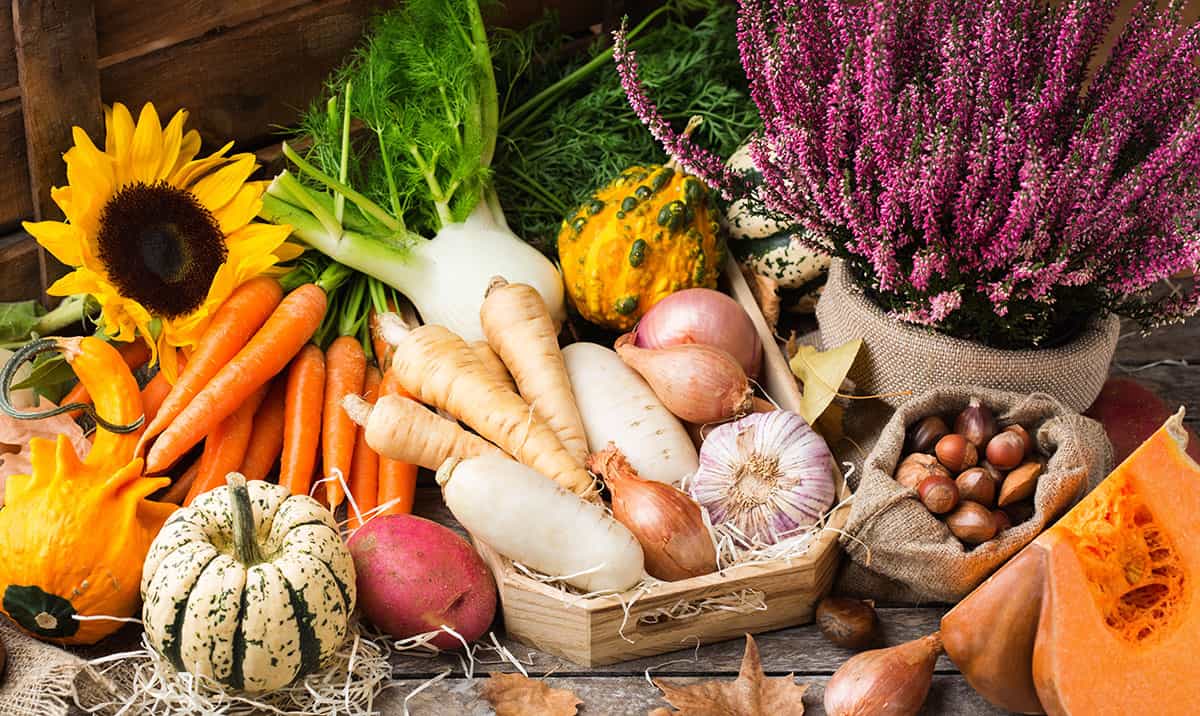In my family, we produce a lot of food in our garden, and as a backyard farmer, I have long dreamed of buying more land and becoming fully self-sufficient. But how much land does that really take?
There are many interesting answers to that question around the web, but typically with very few concrete calculations, and often they seem unnecessarily optimistic. There are also examples of people growing large quantities of food on minimal land using unconventional methods. Still, I find myself missing some data, as extreme examples are not necessarily what most of us can or want to reproduce.
Land can be expensive, and although I personally would love to own 1,500 acres in no man’s land, it’s nice to know with some certainty how much land we really need to be able to provide the family with food and other necessities.
This is one of the longest and most thoroughly analyzed articles I have ever published online. But if you just want a quick summary, below is the result I came up with. Also, feel free to check the table in the section marked ‘In Summary’.
A family of four can be fully self-sufficient with basic foods on about 0.8 acres. To vary the diet with fruit, berries, and a little meat, 1 to 1.7 acres is a realistic requirement. If you also wish to be fully self-sufficient in steaks and bacon, up to 20.2 acres will be needed.
This analysis is based on my own location in hardiness zone 7. If you live closer to the equator, it’s possible to grow food during a longer part of the year, and thus the need for space will be less.
The data below is based on my own research, led by a dream of becoming self-sufficient. The purpose is not to provide a complete guide to becoming self-sufficient (you can use The Self-Sufficient Life and How to Live It for that), but to share my considerations with those interested and provide a reasonably reliable estimate of land requirements.
Also, note that I use conservative estimates. Professional farmers will typically be far more efficient than backyards and small family farms.
Table of Contents
What Does Self-Sufficient Mean?
Self-sufficiency, in its strictest sense, means being able to produce everything you need by yourself. That is food, clothing, a roof over your head, tools, furniture, etc.
I am not claiming that kind of self-sufficiency is impossible, but one must really want it. And then one must at the same time be willing to live as in the Stone Age because everything invented during the Iron Age and onwards requires a degree of expertise that one person or one family cannot produce by themselves.
Fortunately, however, there is also room for less restrictive definitions of the term, which allow for a more moderate degree of self-sufficiency. And which still provides an increased degree of control over what one consumes and potentially also a financial saving.For many, the concept primarily covers being self-sufficient in food, which is also the subject of this article. However, there are other aspects of self-sufficiency, including electricity and heat.
Can You Save Money by Being Self-sufficient?

For many, self-sufficiency is about saving money. This is partly true in the West, but to a much lesser extent than in poorer countries, where chickens in the backyard and a small kitchen garden are a necessary supplement to many people’s other income.
This was also the West’s case until we became wealthier and started copying the nobility’s penchant to cultivate and maintain lawns. Before then, all of the individual small land plots were used as kitchen gardens among the underclass and the budding middle class.
Modern agriculture is extremely efficient. Five pounds of wheat flour costs around $2.5, which corresponds to about 6 minutes of work for a typical employee. Such prices are difficult to compete with if you want to grow your own wheat and then grind it into flour.
This does not mean you can’t save money by being self-sufficient – you certainly can if it’s done right. But not always if the value of your time is taken into account.But a purely monetary cost-benefit analysis is not the only way to assess whether something is worth doing! Other factors matter, such as the pride of producing what you consume, awareness of what you eat, and knowledge of where it came from. Many simply prefer to spend 3 hours working the land rather than spending 1 hour at the office.
How Much Food Do We Need?
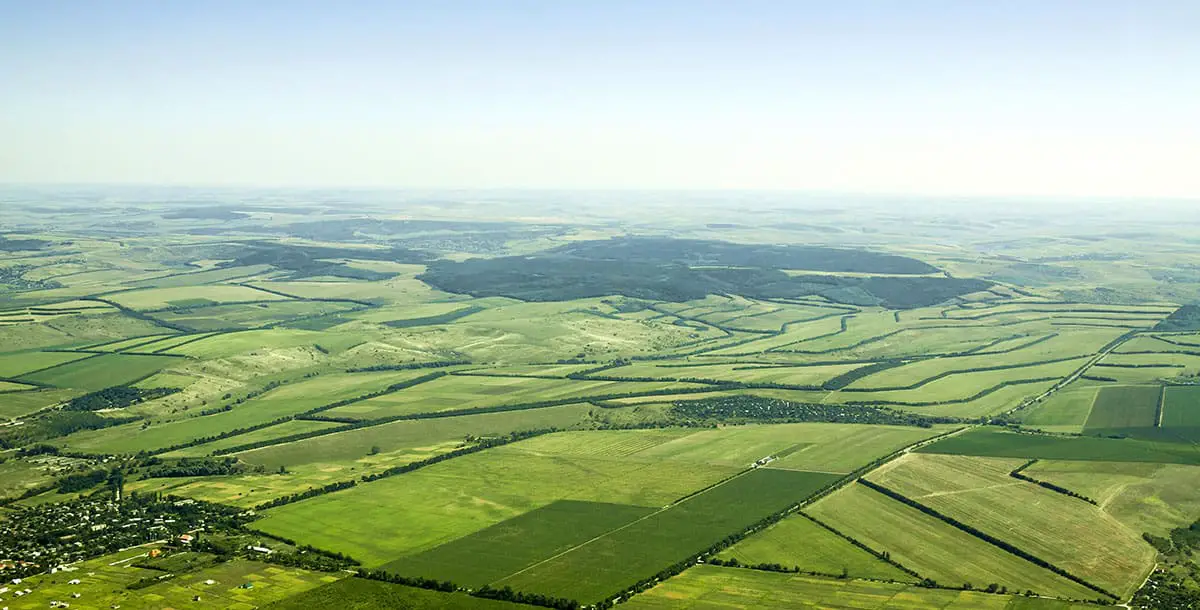
On average, we consume 3 to 4 pounds of food a day, but there is obviously a big difference between eating 4 pounds of lettuce and 4 pounds of bacon. Therefore, to assess how much food one needs to grow to be self-sufficient, it’s necessary to know how many kilocalories (kcal) we require. Because without knowing our calorie needs, it’s impossible to know how much food we need to avoid a caloric deficiency.
It’s recommended that women consume 2,000 kcal a day and men 2,500 kcal. At first glance, that sounds like a lot, but if you grow your own food, you will undoubtedly need at least this food intake, so let’s consider a daily average need of 2,250 kcal.
But counting calories is not enough. We also need a wide variety of nutrients to avoid improper nutrition. Therefore, I have found four crops that provide a high-calorie yield per square foot and, at the same time, cover most of our nutritional needs.
Vegetables and Root Vegetables
Vegetarians will find it easiest to become self-sufficient on a small plot of land. This is because animals must consume more than they produce in the form of meat and eggs.
One of the most effective foods to grow is the ever-popular potato. This tuber is perhaps the most effective way to stay nourished cheaply and on limited land. The potato contains many of the necessary micro and macronutrients needed to live a healthy life. It would be an exaggeration to say that you can live on potatoes alone, but it’s not that far off.
However, potatoes do not contain all the necessary nutrients, so kidney beans are another important ingredient in our minimalist food style. Besides providing a high-calorie yield per square foot harvested, kidney beans are rich in protein, iron, calcium, magnesium, and dietary fiber. And then they taste great!
However, we still lack a vitamin A source, and so the carrot comes into the picture. This also contributes to a variety of flavors and a wide range of cooking options. At the same time, you can eat carrot tops and use them in a salad. The tops are rich in vitamin A, dietary fiber, vitamin C, calcium, and iron.
If you combine potato cultivation with carrots and kidney beans, you are pretty well covered and will probably be able to live a very long time without lacking vital nutrients.
Besides, potatoes are easy to store in winter, carrots can be boiled and frozen, and kidney beans can be dried or frozen.
Necessary Fats
However, none of the three mentioned foods contain a lot of fat, and therefore it will be necessary to add a fourth crop. Many efficient vegetarian sources of fat are either illegal to grow in some places (hemp seeds) or unrealistic to cultivate in sufficient quantities in colder regions (e.g., avocado and olives).
Of course, you can grow and use rapeseed or corn oil, but an easier fat source is nuts. So if you are going to live off of homegrown products, you should have some big nut trees as well. In particular, hazel, which yields relatively fast yields and can be grown in most soil types.
Isn’t It Boring to Live on Only Types of Food?
Yes! It gets pretty dull within a short time. This is intended to illustrate what is required as a minimum to be completely self-sufficient, but you can easily supplement several other options. For example, grow different kinds of root vegetables instead of just potatoes, or plant squash in addition to the beans. The most important thing is to choose products that provide the necessary intake of various nutrients.
Since the four mentioned crops are among the most efficient products, it will often require more space and more work to cultivate a taste-varied diet. For example, you get a little under 2,000 kcal from 10 square feet of potato harvest, whereas you have to grow almost 60 square feet of lettuce to achieve the same caloric intake.
How Many Potatoes, Carrots, Nuts, and Beans Would We Need Then?
A diet consisting of 40% potatoes, 15% carrots, 30% kidney beans, and 15% hazelnuts would look like this to achieve a daily calorie intake of 2,250:
| Kcal/100g* | Need/day(kcal) | Need/day(oz) | Need/year(lbs) | |
|---|---|---|---|---|
| Potatoes | 77 | 900 | 41.2 | 427 |
| Carrots | 41 | 338 | 29.0 | 300 |
| Kidney beans | 333 | 675 | 7.2 | 74 |
| Hazelnuts | 628 | 338 | 1.9 | 20 |
Note: This is not a dietary recommendation but an example of a reasonably well-balanced diet.
Now we have a good idea of how much and what kinds of food we need to produce. But how much land do you need to grow it all?
Below is the expected yield for the four crops. To use conservative worst-case results, the numbers are at the lower end of the data, I have been able to find.
- Potatoes provide approx. 22,000 lbs per acre
- Carrots provide approx. 8,900 lbs per acre
- Kidney beans provide approx. 4,500 lbs per acre
- Hazelnuts provide approx. 900 lbs per acre or 5.5 lbs/tree
For one person or a family of four to become self-sufficient, they will need to cultivate:
| lbs/sq. ft. | sq. ft./person | sq. ft./family 4 | |
|---|---|---|---|
| Potatoes | 0.51 | 1,837 | 5,511 |
| Carrots | 0.20 | 3,234 | 9,702 |
| Kidney beans | 0.10 | 1,593 | 4,778 |
| Hazelnuts | 0.02 | 2,111 | 6,334 |
| Total | 8,775 | 26,325 |
In other words, a family of two adults and two smaller children must cultivate 0.6 acres to be self-sufficient in the most necessary food. However, it will be advantageous to grow 15 – 20% extra beans and potatoes to set aside for next year’s sowing. I.e., an additional 2,058 sq. ft.
Crop Rotation
It’s also necessary to add some land corresponding to the most space-consuming crop so that you can rotate the crops at four-year intervals.
This all amounts to a total of 35,000 square feet or 0.80 acres for a family of 4. This additional land can be used to keep some chickens that can fertilize the land, or you can grow a fourth crop.Crop rotation is done primarily to avoid excessive pests and plant diseases associated with each plant species, whereas their nutritional needs can be met by fertilizing.
Permaculture and Fertilizer

Are you self-sufficient if you fertilize? Of course, that depends on how strict we define the term. But if you want to be 100% self-sufficient, the compost pile and possibly land set-aside are important factors.
Back in the days, farmers didn’t just rotate crops to avoid disease. A plot of uncultivated land was also included in the rotation. This gave the soil time to regain its nutrients before it was cultivated again. We have already taken this into account in the calculation, as we have added an extra plot of land for crop rotation.
However, set-aside is not necessary if the soil can be fertilized effectively in other ways. This can be done, for example, by making your own compost and/or manure with the animals’ feces – more about this in the section on poultry farming.
It would also be advantageous to get acquainted with the concept of permaculture. Permaculture is basically about cultivating in a way that is in ecological balance.
If you search for a definition of the term on the web, you will come across many vague terms, such as ‘holistic’ and ‘harmonious,’ and it can be difficult to really understand what the concept is about. Also, permaculture has a political aspect.
But in practice (and very simplified), permaculture means that you grow your foods in a sustainable, local, partially closed system and, among other things, do not use poison or carry nutrients to and from the property. You also utilize your resources as efficiently as possible, for example, by finding several uses for the same resource.
For example, it is (again, in simplified form) in line with permaculture if you feed chickens with home-grown feed, which has been fertilized with your chickens’ poop.
Grain Products
A somewhat demanding crop is grain products, including the production of foods that needs flour. Growing wheat requires almost 15 square feet per pound of flour (this is a conservative estimate. Professional farmers are far more efficient).
Also, processing wheat and other grains is not a simple task. You either have to spend a lot of time harvesting in an old-fashioned way, or you have to use machines. Then grind it into flour.
This is not to say that it’s impossible to grow your own grain, and smaller areas are, of course, easier to manage. Here is a video that brilliantly shows how to grow and use wheat on a very small plot of land:
It really is a pleasure to bake with home-ground flour, but it is also time-consuming considering how cheap flour is in the shops. Therefore, it may be worth considering whether one can live without wheat flour.
Alternatively, you can do an in-between solution by buying the grain from a local farmer and grinding it yourself with an affordable hand mill or an equivalent electric model. A hand mill can also be used to grind malt if you want to brew your own beer.Alternatively, corn can be used. Corn is not terribly difficult to grow, it is easier to harvest by hand, and it can also be ground with a hand mill. Cornmeal can’t always be used as a direct substitute for wheat flour, but you can instead use baking recipes that require cornmeal. And you can make popcorn as well!
Free Foods!

A menu consisting of potatoes and beans soon gets dull. If you have a property of more than a few thousand square feet, then you will likely have wild stinging nettles, goutweed, dandelions, and other eatable so-called weeds.
These plants are full of vitamins and minerals, and they can provide a variety of tastes to your self-sufficient diet. You may also be able to find edible mushrooms, which will also contribute new flavors.
Herbs
An effective way to add flavor to your food is to grow herbs such as mint, thyme, sage, chives, dill, and rosemary.
The good thing about herbs is that you get a lot of bang for your buck. The amount of calories is negligible, but you can easily grow a year’s worth of herbs within a few square feet.
Herbs are also easy to dry and store so they can be used all year round.
And now that we’re talking seasoning, salt is also a necessity for most people. Partly because it adds flavor but also because salt-curing is an efficient way to preserve meat. If you live near the ocean, it’s fairly easy to extract salt from seawater. You should be able to extract about 3 – 4 ounces of salt per gallon of seawater.
Self-sufficiency in Fruits and Berries
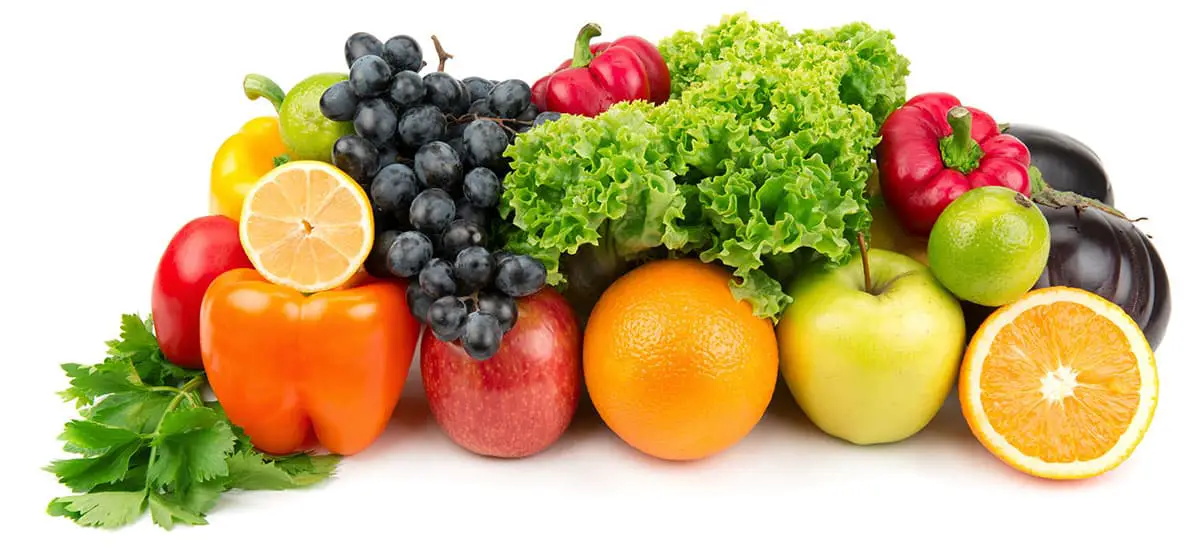
Fruits and berries are not the most efficient crops per square feet, but your work effort is less, as trees and shrubs do not require as much attention once they have taken root. At the same time, it is undoubtedly the most satisfying form of self-sufficiency.
Plant a variety of trees and shrubs with varying ripening times. Then you are less exposed in case of plant diseases, and you can harvest over a longer period of the year. Also, think carefully about the layout before planting.
Of course, if you grow fewer types of berries and fruits, it will be easier to manage. The examples below are if you want a varied selection.
Fruit Trees
It’s a bit difficult to assess the optimal number of fruit trees. For example, one or two apple trees are plenty for a family of four, but only when they have grown large. Besides, it is good to have a few extra trees in case one dies or doesn’t yield so many fruits in one year.
Better too many than too few fruit trees, unless space is a challenge. Having too many fruit trees does no harm, can always be used for fodder and, in the worst case, firewood.
Consider whether the fruit trees should be full-sized or dwarf varieties. Dwarf trees are good for espalier, and the fruit is easy to reach. But they never turn into big, beautiful trees that take care of themselves.
Plant also:
- two pear trees.
- two almonds. Almond trees need time to grow, but fresh almonds taste great. Almost like marzipan.
- two peaches (cold hardy variants exist)
- two fig trees (cold hardy variants exist)
- two cherries
Conservatively assessed, growing all the trees above will take up 13 trees of approximately 377 square feet each, or a total of 4,900 square feet, depending on varieties and how you utilize the land. For example, espalier will take up less space than trees standing alone.
Berry Production
Redcurrants and blackcurrants are great berries that can be used for juice, food, and much more. However, it takes some years for these shrubs to become large enough that you can be self-sufficient. 4-8 plants of each (194 – 388 square feet) will provide a solid yield. They can be used as hedges for optimal land utilization.
Raspberries are also an excellent plant to have. Two beds of 108 square feet with summer and autumn raspberries, respectively, will yield about 45 pounds annually.
Strawberries are also nice to have. A 160 square feet bed will provide an annual yield of about 65 pounds.
Plant also:
- a couple of blackberry bushes (65 sq. ft. in total)
- at least two grapevines (65 sq. ft. in total)
- a jostaberry (45 sq. ft. in total). The plant grows quickly and produces a lot of berries.
- 2 rhubarb (a total of 45 sq. ft.). They are ready for harvest before anything else.
All of the above will occupy approximately 887 square feet – depending on variety and how the land is utilized. For example, hedges will require less space than free-standing shrubs.
How About a Greenhouse?
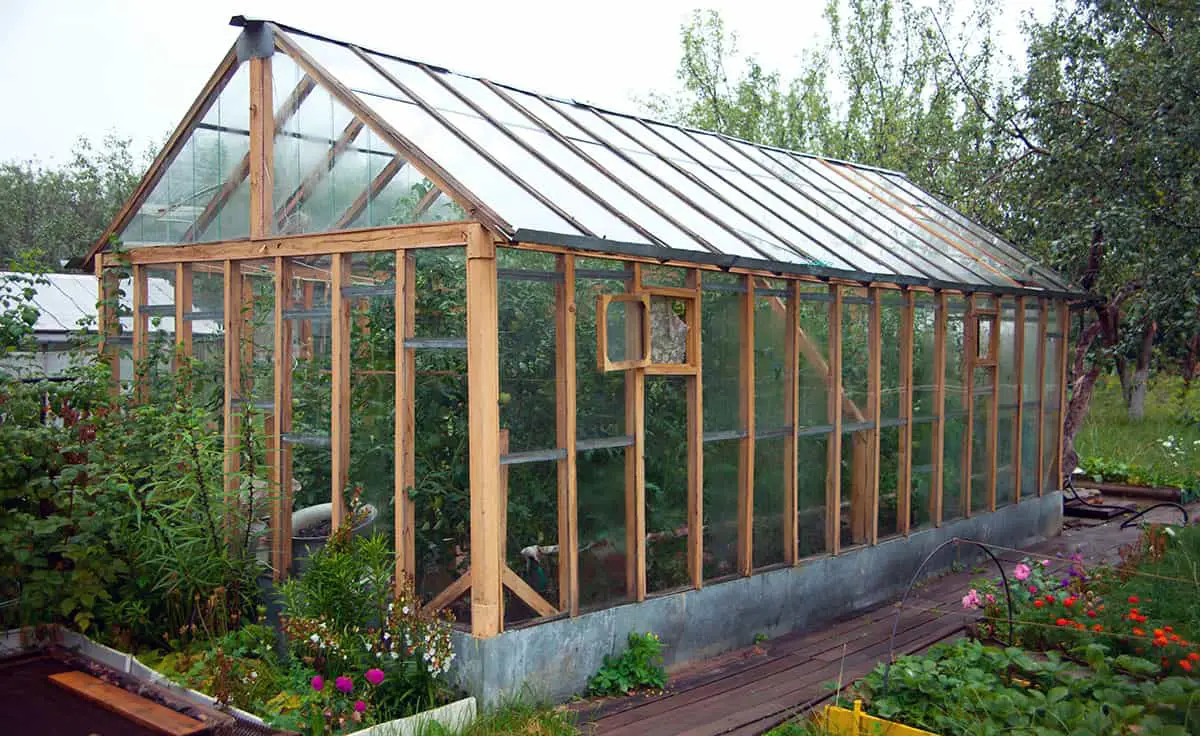
If you take self-sufficiency seriously and want to consume other foods than potatoes and beans, then a large greenhouse is almost necessary.
A greenhouse extends the growing and harvesting season. You can grow plants that can’t normally grow in colder climates or get a higher yield in your greenhouse. For example, peanuts, cucumbers, tomatoes, peppers, eggplants, and melons.
Orangery
You can also build an orangery and thus produce fruits that are even more exotic. The difference between an orangery and a greenhouse is that the orangery is insulated and can be heated on freezing winter days.
In the past, the orangery was the kings’ and the very wealthy’s way of getting exotic fruits that would otherwise have to be shipped from warmer climates and which were difficult to deliver before they rotted.
An orangery makes it possible to grow citrus fruits without having to move the plants inside during winter. You can also have a small production of olives, kiwi, and other imported goods.
Realistically speaking, an orange tree will not get much taller than seven feet in most of hardiness zone 7, which probably fits well with the height of your orangery. The yield will also be somewhat lower than in warmer climates, and one should not expect to be able to eat tons of homegrown exotic fruits, but instead consider it a luxury.
An Example of Self-sufficiency in Fruits and Vegetables from a Greenhouse
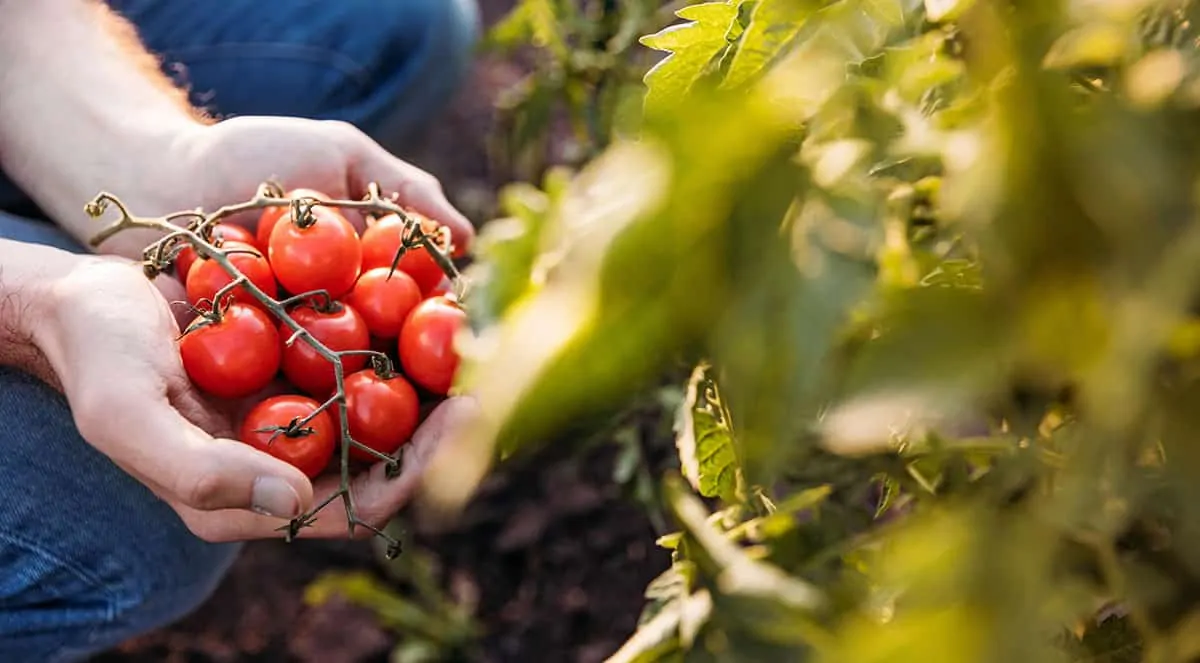
We eat an average of about 55 pounds of tomatoes annually, and a tomato plant yields about 7.7 pounds of tomatoes. To supply one person with tomatoes, it takes about seven plants or 21 plants for a family of four. A tomato plant should have about 5.4 square feet, and therefore all 21 plants will occupy about 113 square feet.
Assuming roughly the same yield, space requirements, and twice as much total consumption of other fruits and vegetables (e.g., cucumbers, eggplants, peppers, and melons), we need to add another 226 square feet. Thus we need a total of 339 square feet for full self-sufficiency for a family of four plus about 100 square feet so that you can move around within the greenhouse.
This will not yield a significant amount of calories, and potatoes will remain our main course. But it will produce enough for us to have a considerable flavor variation throughout the year.
Some varieties of cucumbers and tomatoes can also be grown in the open. In which case, the greenhouse could be used for the more exotic plants.
Can You Grow Coffee and Citrus Fruits in Colder Climates?
Many can not do without their morning coffee. The coffee plant requires heat and cannot be grown on a large scale in colder climates, but I have been told that it is possible to grow coffee plants on the windowsill.
The same can be said of citrus fruits. You can grow lemons, oranges, and the like in large pots. However, it requires a bit of extra work without an orangery because they have to be moved indoors in the winter (preferably to a cooler part of your house) and put out again in the summer.
Chili is perfect for the window sill. Of course, it can also be grown in the greenhouse, but it doesn’t take up much space and fits nicely into a window sill. Then you can use the greenhouse for other plants.
Self-Sufficiency in Meat
How much land you will need depends to a large extent on what kind of meat you want. Different types of animals have very different needs.
Poultry has the lowest feed conversion ratio. This means that, compared to other animals, they need the least amount of feed per pound of meat.
At the other end of the scale are cows that need more than four times the amount of feed that chickens need to increase their bodyweight by the same amount.
Besides, there is some correlation between feed conversion ratios and space requirements, as the feed conversion ratio is positively correlated with the animal’s size. That is, large animals need more space – also relative to their size.
Animal husbandry can be done in three ways: limited space with large amounts of supplementary feed, pasture-raised with very little feed, or something in between the two extremes.Below I assume that the animals are kept on pasture as much as possible and therefore need more space but less supplementary feed.
Poultry
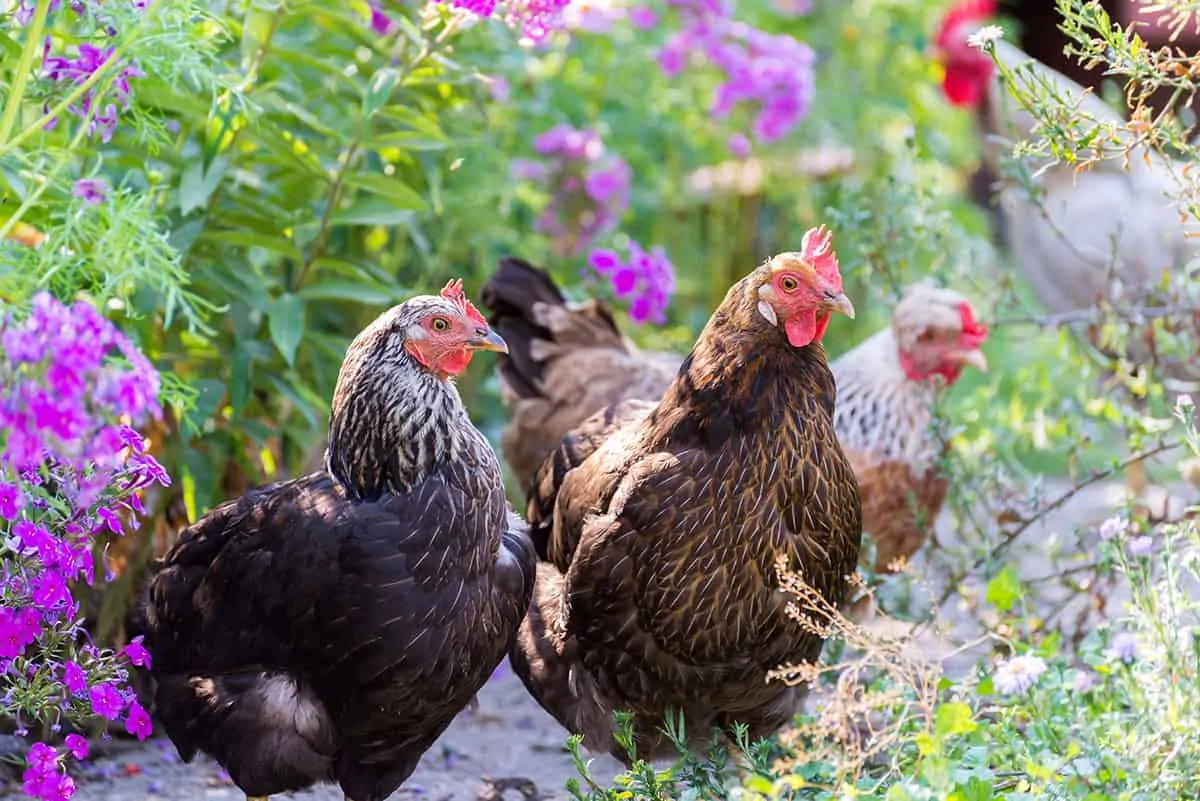
As mentioned, chicken keeping is one of the most efficient forms of meat production. The same applies to other poultry, such as geese, ducks, and quail. However, chickens are among the easiest poultry to keep, and it’s no coincidence that chickens are by far the most popular poultry in backyards and small family farms.
If you need more variety, you can supplement with a few types of poultry. For example, the taste of the Muscovy duck is reminiscent of tender roast beef. But for most people, chickens will be the primary source of animal protein.
How Many Chickens Should You Have?
An efficient chicken breed such as the Australorp lays about 250 eggs a year, and the average American eats 279 eggs a year. Considering my family’s egg consumption (including baking and homemade ice cream), that seems about right.
If we round up to 300, each person needs 1.2 laying hens or 5 hens for a family of four. But to be “really” self-sufficient, we need to hatch our own chicks, in which case a rooster will also be needed.
If a family eats 2 chickens a week, that equates to 104 a year. If we consider that not all eggs are fertilized, and not all young chicks live long enough, you need an extra egg-laying to keep the production of chickens going.
A total of 6 hens plus one rooster.
How much land should seven hens take up? Not very much.
The great thing about chickens is that they can mostly move around freely without running away. Of course, they must be kept out of the kitchen garden but can otherwise be let out in the morning and more or less take care of themselves throughout the day.
Of course, it is important to have a chicken run for when you are not at home (as protection against predators). But if you let them out most of the time, it doesn’t have to be bigger than 110 square feet for a flock of 7 chickens. Coop included.
Chicken Tractor for Chickens and Meat Chickens
A popular method of chicken keeping is to use a so-called chicken tractor. I.e., a mobile chicken house and run. By moving the tractor around at regular intervals, they will scratch and fertilize the land for you.
A device like this of close to 200 square feet can easily house a medium-sized flock of broilers. This will reduce the need for a supplementary feed and effectively fertilize a set-aside area but will not reduce land use since chicken tractors have to be moved.
How much feed to grow?
Chickens can, to a large degree, feed themselves if given the opportunity. However, they should always have access to supplementary feed.
According to this very informative calculation, a chicken eats just under 100 pounds of feed per year, which fits well with other sources I have come across. They then calculate that you need to grow 1,140 square feet of corn, soy, and oats to feed a hen for a year. Thus 7 hens need 695 pounds of feed or 7,987 square feet of cultivated area.
In my experience, this is quite a high estimation in the case of small chicken flocks, which can largely live on your kitchen scraps and what they find in the garden. Our flock of comparable size eats about 220 – 330 pounds of supplementary feed annually. But it’s better to overestimate than underestimate the need for feed.
Briefly summarized
A small flock of hens for egg production would need about 110 square feet and up to 8,043 square feet to grow their feed.
Self-sufficiency in both eggs and meat will thus require a total of approximately 22,000 square feet of land.
| Chickens | Cultivated area (sq. ft./chicken) | Pasture (sq. ft.) | Cultivated are (sq. ft.) | Total (sq. ft.) | |
|---|---|---|---|---|---|
| Adult chickens | 7 | 1,149 | 110 | 8,043 | 8,153 |
| Meat chickens | 104 | 123 | 1,120 | 12,792 | 13,912 |
| Total | 1,230 | 20,835 | 22,065 |
Pigs
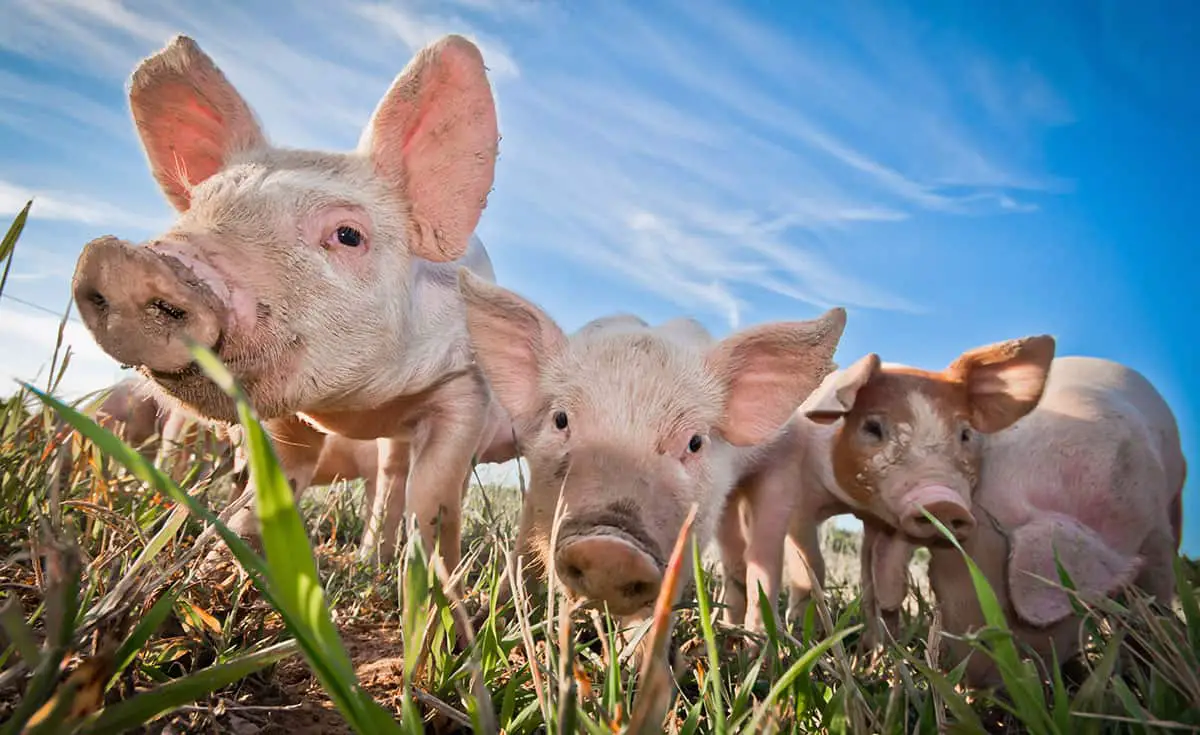
Pigs do not take up that much space either, and they have a better feed conversion ratio than cows.
Three free-range pigs should have approx. 1,200 square feet to live on if you use rotational pasturing, which minimizes their feed needs. In that case, they each eat about 5.5 pounds of grain a day, although it largely depends on the pig’s age and size.
How much feed to grow?
As mentioned, the annual feed requirement depends on whether it’s a meat pig or an adult sow/boar. A reasonable estimate for three pigs is 5.5 pounds of feed times 365 days, corresponding to 1 ton per year. That will require a cultivated area of 73,668 square feet.Note that the feed estimate for pigs is calculated based on wheat production. No animal can live on wheat alone, but the calculation gives a reasonable estimate of how much space you will need to cultivate to keep them well-fed.
Goats
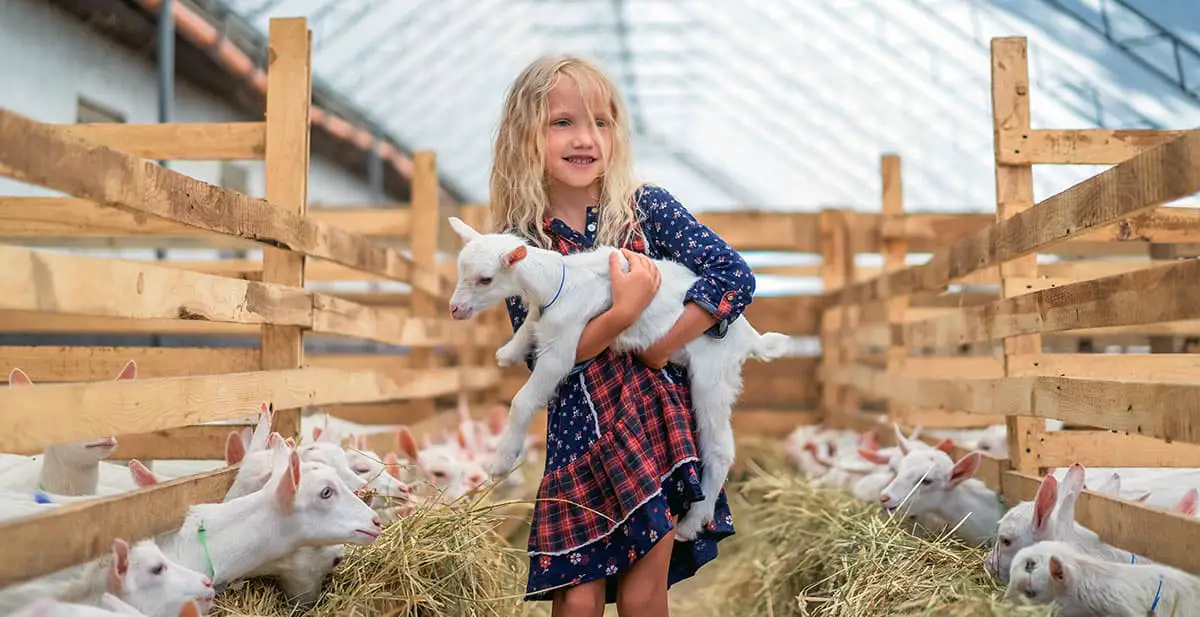
Goats are a fantastic source of milk production and all kinds of dairy products. Sure, cows are the most popular milk source, but they are also much harder to keep. Goats, on the other hand, are perfect for the small self-sufficient family.
Here’s a good summary of the advantages and disadvantages of keeping cows and goats, respectively.
Although adults may not drink much milk, butter is a nice thing to have. Not to spread on your bread, but because it can be used for baking and in place of cooking oils. And who wouldn’t like to be self-sufficient in both cheese and ice cream?
One goat can easily provide half a gallon of milk a day, which is plenty for most families’ needs. However, goats are social animals, and therefore it is necessary to have two. One of them could be a buck, so you can expand the herd with kids for meat and/or continued milk production.
Free-ranging goats should have around 5,400 square feet per goat to keep feed requirements down. That’s 10,800 square feet for two goats.
How Much Feed to Grow?
Goats love hay and alfalfa so much that they eat around 3 pounds of it every day.If we can grow 4.5 tons of hay/alfalfa per acre, then we need to grow 11,000 square feet to keep both of them full and satisfied throughout the year.
Cattle
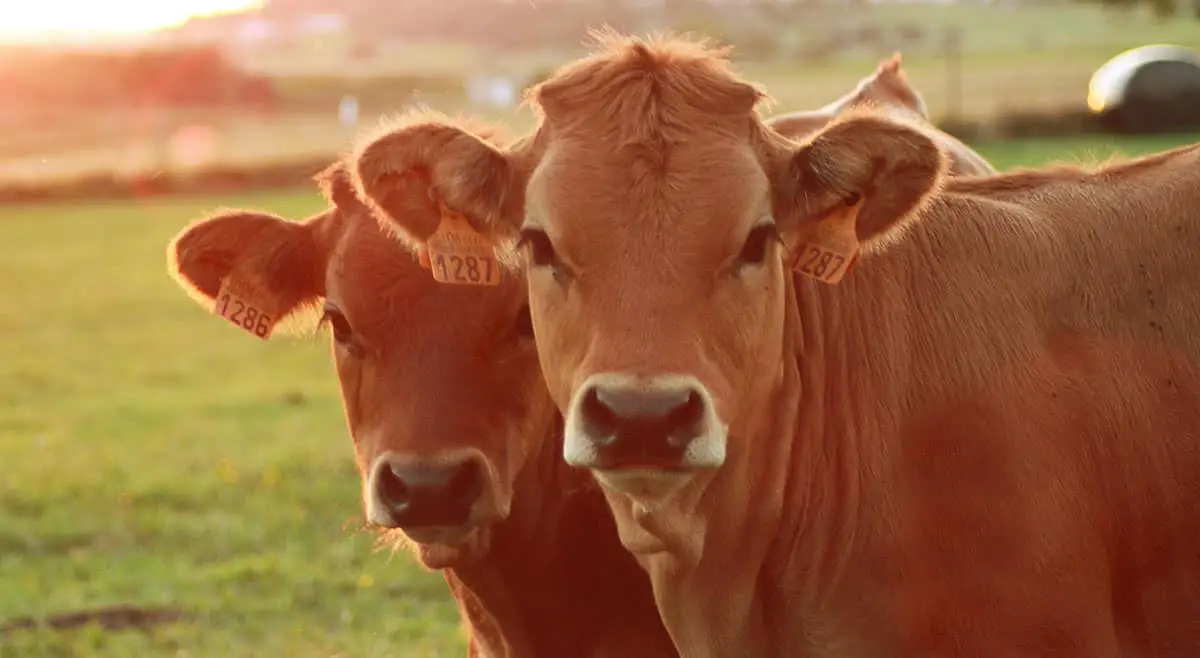
Cattle are probably the most demanding animals to keep for self-sufficiency. You don’t just buy a herd of cows and put them out on a small field. They are large animals to handle and to butcher, and they eat a lot.
Another challenge with keeping cows is that they produce gallonsof milk. 2.5 gallons a day at the low end, which is a lot of milk to make good use of. If you can sell the surplus, it may not be a bad deal. Otherwise, it can (literally) be too much of a mouthful.
Cows are social animals, and although some people keep a single dairy cow, two are preferable. How much land they should have depends on many factors, including how good the grazing area is, but about 4 acres should allow them both to graze full time during the summer.
How Much Feed to Grow?
A cow needs approximately 130 pounds of feed per day consisting of a mix of hay/alfalfa and supplementary feed plus 25 gallons of water.
Assuming that two cows primarily feed on grass 4 months a year, this is equivalent to cultivating an estimated 12.4 acres of feed.
Other Animals
In addition to the four animals mentioned above, there are other options as well. For example, poultry such as geese, ducks, quail, turkeys, or even ostriches. And if you have a hunting license, you can bring home birds and venison.
Rabbits are also an option. Rabbit meat is healthy and low fat, they do not take up much space, and they don’t require a lot of feed.
An excellent alternative to goats is sheep, which, in addition to meat, also has wool. And while this was news to me, it turns out you can drink sheep milk, and apparently, the milk is both healthy and tasty.
Fishing and Aquaponics
Fish is healthy, and one way to be self-sufficient in fish meat is to get a fishing license and go fishing. The great thing about fishing in the rivers, lakes, and seas is that it doesn’t take up land on your farm.
Although you could get quite hungry if your next meal depends on your fishing rod, but you can also use fixed gear, including fish traps and gillnets. Fixed gear makes it much more realistic to become self-sufficient in fish. This is a regulated subject, though, so make sure to check with your local authorities.
Another way to become self-sufficient in fish is to have your own lake of freshwater fish. However, it’s not that simple in practice, and a small garden pond is far from enough. You need at least 2,500 square feet, and even then, you would find it hard to maintain a healthy stock.
A third, and lesser-known, way of having your own supply of fish, shrimp, or shellfish is to use aquaponics. Aquaponics combines fish farming with plant cultivation.In short, the fish’s waste is pumped to the plants, which utilize the nutrients, after which the now clean water is returned to the fish.

Proponents of aquaponics say that the method is so effective that one can become self-sufficient in fish and vegetables on quite a few square feet.
Water
Water is not the first thing that comes to mind regarding self-sufficiency, but it’s just as much a part of the concept as food.
To get your own drinking water, you will need a well, which does not take up much space. But note that it can be costly to drill a well, and often you don’t know in advance how far you have to drill. This is not a cheap project but may well be worth your money.
You can also just be self-sufficient in water for your garden. In which case, it’s adequate to buy a few water tanks (or trash cans) for collecting rainwater and connecting them to the downspouts. It’s a fairly easy process and doesn’t cost a fortune.
If you want rain barrels to be your main watering system, it can quite a task to carry the watering can back and forth (believe me!). If gravity is on your side, you can connect a hose to a tap at the bottom of the tank; otherwise, an affordable submersible pump like this one is very effective. I use it myself for many purposes, including watering the kitchen garden.
Sugar and Sweetener
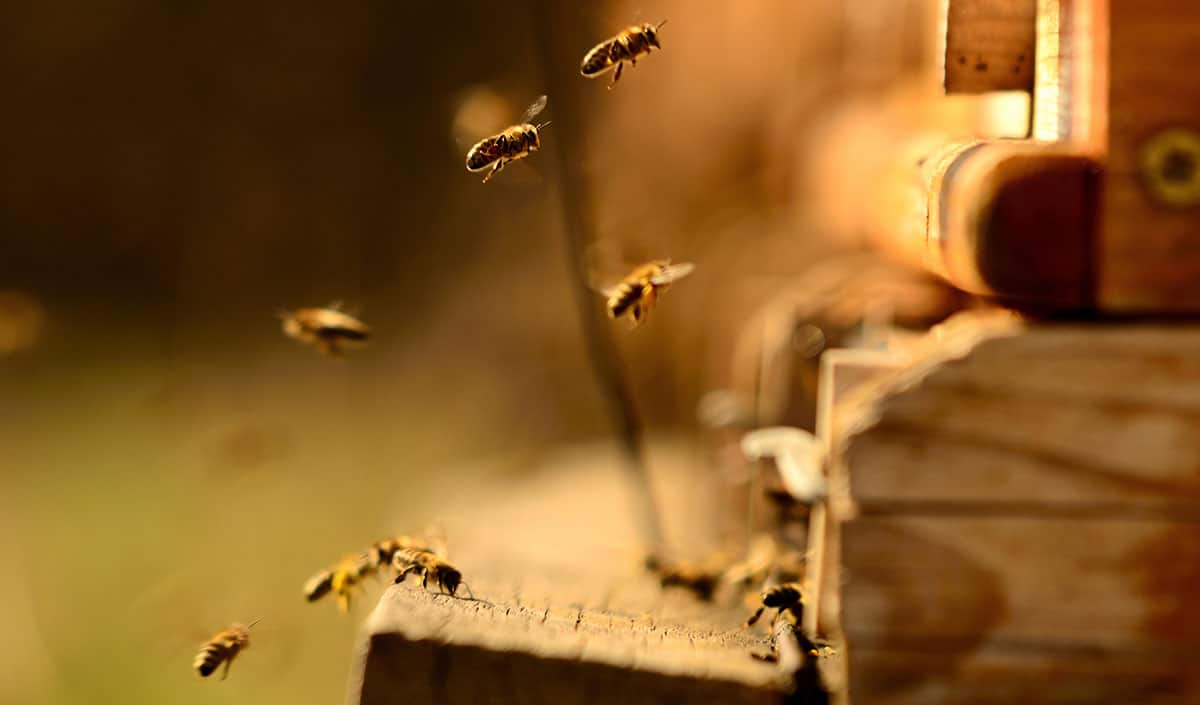
You can easily produce lots of sugar, even if you live in a climate that doesn’t support sugar canes. Here are four sources of sugar and sugar substitutes that you can produce in most regions:
Stevia
Stevia is undoubtedly the easiest way to produce your own sweetener. It has an aftertaste that’s a bit like licorice, and not everyone loves it. It also doesn’t have the caramelizing function of sugar, so it works better as a sweetener than for baking. Although, you can easily substitute stevia for about half the sugar in jams and other sugary products.
You can grow plenty of stevia for yourself and your family on just half a square foot.
Beekeeping
Beekeeping requires more work and a higher upfront cost than stevia. But it’s a cheap and effective way to obtain honey once you have the equipment. Honey is a healthy sugar substitute.
One beehive can easily produce at least 90 pounds of honey a year, and a hive requires up no more than about 5 square feet. Besides, bees are effective pollinators and will contribute to a bigger harvest.
In my opinion, beekeeping should be one of the first projects that anyone who wishes to become self-sufficient takes on.
Sugar beet
The sugar beet is a root that contains approx. 20% sucrose, which can be extracted and converted into sugar. This is done by grating or blending the beets and then boiling the beet juice until the sugar crystallizes. However, the process is more complicated than that, and it can be difficult to get the beet flavor out of the sugar.
On the other hand, it only takes a relatively limited area to grow beets, as one acre of sugar beet produces about 22 tons of beets or about 4.5 tons of sugar. If a family uses 2.5 pounds of sugar per month, this corresponds to about 30 square feet of cultivated land.
Marple and Birch Sap
If you have a few medium-to-large maple trees on your property, then you have access to lots of free sugar.
Maple sap can be tapped in the spring when the trees pull water up to the canopy. The exact time of year depends on the weather conditions and your location. This is done quite simply by drilling a hole into the tree, attaching a hose to the hole, and letting it drip into a bucket or a bottle. When the bucket is full, it’s recommended to close the hole with a piece of cork to stop the “bleeding”.
If you want to make syrup, cook the sap at low heat to evaporate the water. Maple sap contains up 2 – 5% sugar, and you will need quite a bit of sap as well as some patience. Sugar maple has the highest sugar content, but Norway maple and Silver maple can be used.
Alternatively, you can tap birch trees. Birch sap tastes very fresh, like water with a slightly sweet flavor, and it can easily be drunk as is. Some also make birch sap wine.
Birch sap only contains only 1% sugar, so you will need a lot of birch sap to produce an equal amount of syrup. The concentrated birch syrup tastes sweet and somewhat spicy, which is not to everyone’s liking. But if you like the taste, it can be used for the same as you would otherwise use maple syrup.
Food Storage
As a self-sufficient farmer, you will have to adapt your eating habits to the seasons to some extent. Back in the days, most people had a comprehensive knowledge of when they could eat what. In fact, the seasons were largely represented by certain foods.
Today we are far less dependent on food seasonality. This is mainly because we import a lot of food from other parts of the world, but also because we have refrigerators and freezers available. And most foods can actually be frozen if done correctly.
Fruits and vegetables can be easily stored in the freezer. But you cal also freeze milk and cream if you can accept that it separates a little after thawing. Even eggs can be frozen if done correctly.
The biggest challenge is to find sufficient space for everything, and the more self-sufficient you are, the more freezers you will need. Chest freezers are more energy-efficient than upright freezers, and they typically have more storage space.
Other products can be stored without electrical appliances, such as potatoes; salted, dried, smoked meat; dehydrated greens, etc. Here the biggest challenge is to keep the unwelcome pests away – from tiny beetles in your flour to mice and rats.
Therefore, it’s important to store your food under the correct conditions. All this takes up some space but not very much for a single self-sufficient family unless they also grow hay, straw, and large grain quantities.
In Summary
The table below illustrates three levels of self-sufficiency based on the aforementioned data.Although berries, fruit trees, and meat production take up more space, it also reduces the need to produce as much of the four primary nutrition sources (potatoes, carrots, kidney beans, and hazelnuts). Therefore, I have lowered the land requirement for these by a weighted estimation for each additional food source.

Provided you are willing to live off of a limited selection of vegetables, eggs, and a little honey, then it is possible to be self-sufficient on just under one acre.
If you prefer a more varied diet of fruits, berries, bread, a few goats, and chicken meat, then 1 to 2 acres will be adequate for both your animals and their feed.
For a well-diversified self-sufficient lifestyle, including pigs and cows, about 20 acres may be needed. However, it’s growing the feed that takes up most of the land (and a considerable amount of work). If you are willing to buy their feed, the rest can be done on just over 5 acres.
Remember that if you grow your own animal fodder, you will also need space to handle and store relatively large amounts of grain and hay. Thus there are several good reasons to consider getting feed and grain products from outside sources.
How Self-sufficient Can You Realistically Be On a Quater Acre?
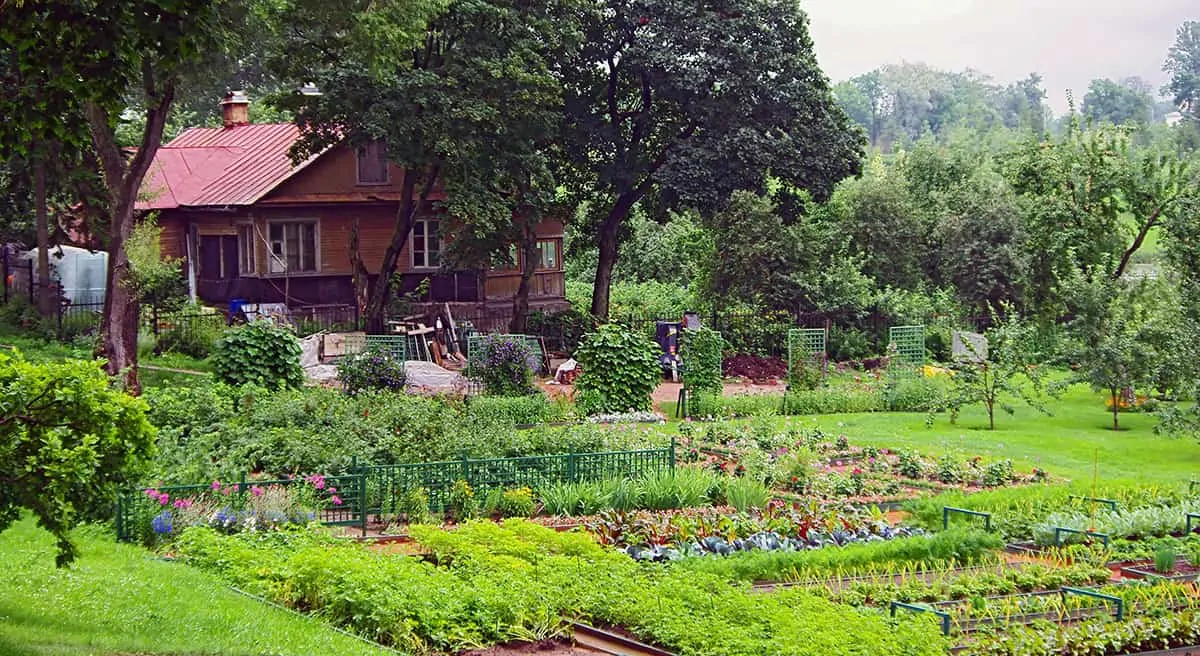
Although it’s hardly possible to live solely off of a typical backyard lot, a quarter-acre backyard can achieve a high degree of self-sufficiency.
For example, on just a quarter acre you can produce:
| Backyard farm (sq. Ft.) | Yield (lbs) | |
|---|---|---|
| Potatoes | 1,500 | 768 |
| Carrots | 1,500 | 307 |
| Kidney beans | 1,500 | 154 |
| Hazelnuts | 1,500 | 31 |
| Buffer/set-aside/rotation/chickens | 1,500 | – |
| Chicken coop and run | 110 | 165 |
| 2 beehives | 45 | 176 |
| Fruit trees | 1,450 | 297 |
| Berries | 1,435 | 294 |
| Greenhouse/orangery | 350 | 72 |
| Total | 10,890 | 2,264 |
As illustrated, you can grow many fruits, berries, and vegetables on even relatively small plots. It will still be necessary to buy some feed, and you may visit your local feed store to keep the chickens well-fed.
But a considerable part of your food can be produced in the backyard if you combine fruit trees, berries, a chicken house, and a varied kitchen garden in a well-thought-out setup.
You can also be creative with plants that complement each other and yield an overall substantial yield. For example, ‘the three sisters ‘(corn, beans, and squash) are grown densely and provide quite a significant yield per square foot.
The question is simply whether one is willing to let go of the lawn.
Many high-production projects require very little space – for example, bees, chickens, and aquaponic projects. In particular, the latter is a great opportunity to experiment within a small backyard or townhouse garden, where you really want to optimize your yield per square foot.
Concluding Remarks
In short, it is realistic to become self-sufficient with a fairly large selection of foods on well under an acre. And if you have up to two acres, there is plenty of space for both interesting projects and animal husbandry.
However, large projects, such as cattle, require far more land. Here the need for space increases exponentially. In my view, that is also unnecessary for most small family farms because you can achieve almost the same results with goats and/or sheep.
If you plan to be self-sufficient, be prepared to learn a lot and to deal with many kinds of defeats and challenges. You do not just throw a seed into the ground and harvest it later. Plants can also get sick, malnourished, and thirsty.
Want to learn more?
The best and most informative book I have read about growing your own little farm is John Seymour’s classic, The Self-Sufficient Life and How to Live It.
Enjoy 🌱

